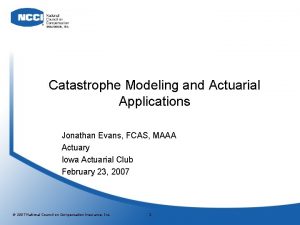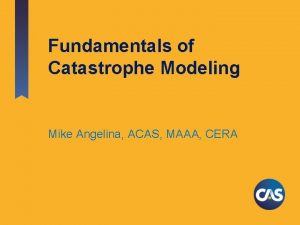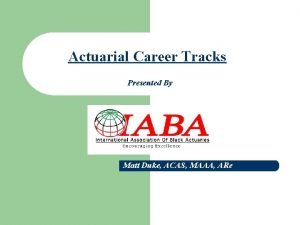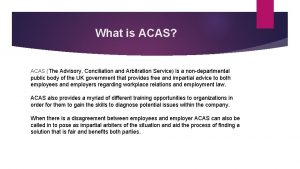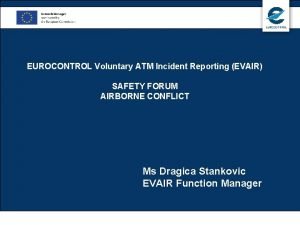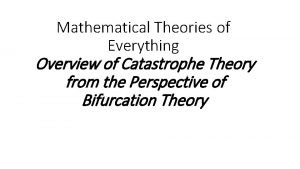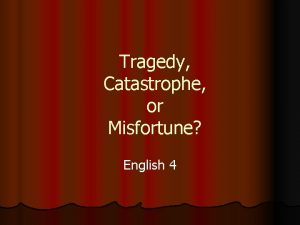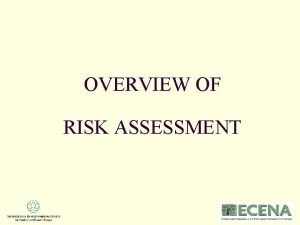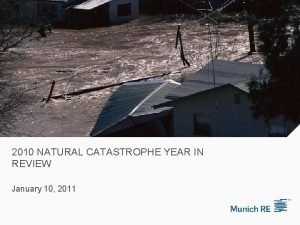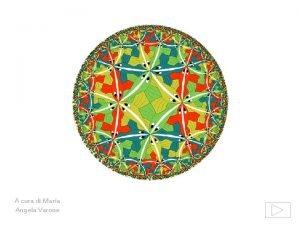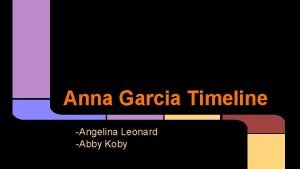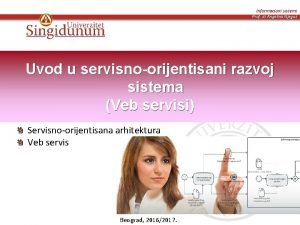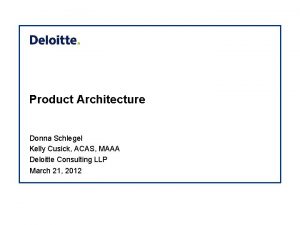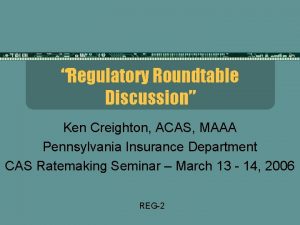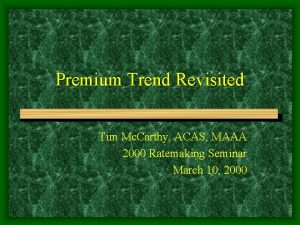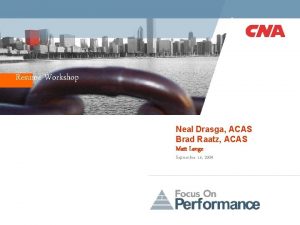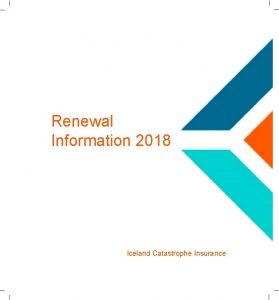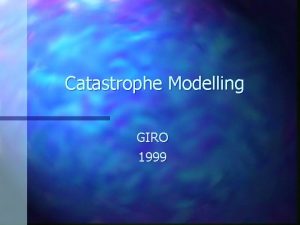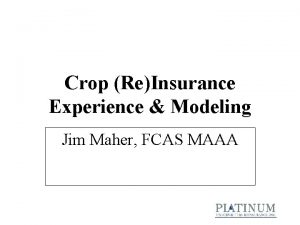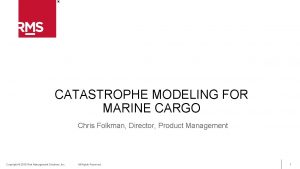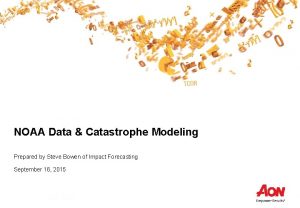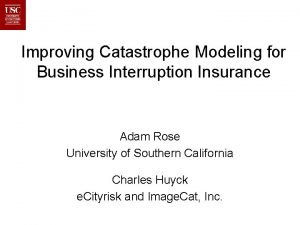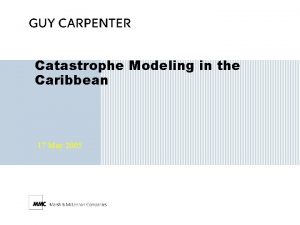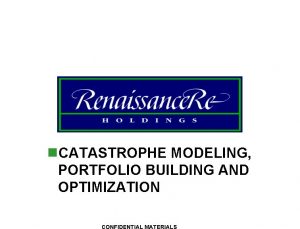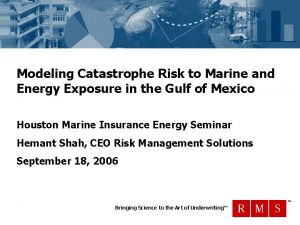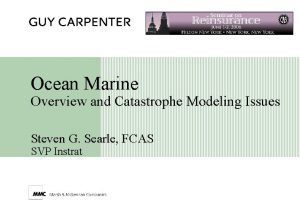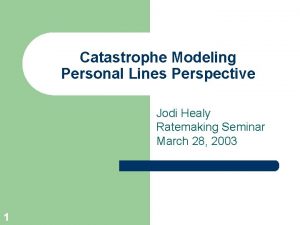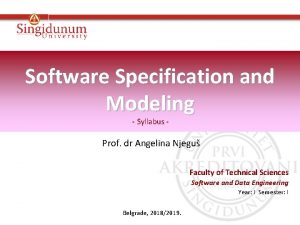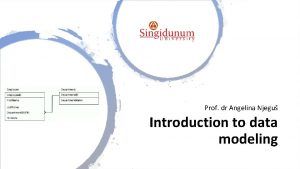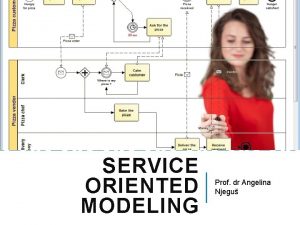Fundamentals of Catastrophe Modeling Mike Angelina ACAS MAAA
































- Slides: 32

Fundamentals of Catastrophe Modeling Mike Angelina, ACAS, MAAA, CERA

Fundamentals of Cat Modeling Example of cat modeling terminology: “The Company’s 100 -year return period loss shall be derived from results produced by Version 6. 0 catastrophe modeling software, using near term perspective, but no demand surge or secondary uncertainty. ” “It would be so nice if something made sense for a change. ” – Alice, from Lewis Carroll’s, Alice’s Adventures in Wonderland © 2014 by the Casualty Actuarial Society. All rights reserved. 2

Fundamentals of Cat Modeling “Prediction is very hard – especially when it’s about the future” – Yogi Berra Agenda Why are models so wrong? What is a catastrophe model? Why use cat models? How cat models work? Cat model inputs Cat model outputs & analytics © 2014 by the Casualty Actuarial Society. All rights reserved. 3

Estimation Techniques Model Results – Katrina Issues Loss Component Gross Industry Loss Modeled Loss First Landfall in Florida $1 - 2 Billion $500 Million Offshore Energy $2 - 5 Billion $1 Billion Wind & Surge, Second Landfall $20 - 25 Billion $12 Billion New Orleans Flooding $15 - 25 Billion - $2 - 3 Billion - Total Estimated Loss $40 - 60 Billion $13. 5 Billion Estimated Loss (excl. New Orleans Flood) $25 - 35 Billion $13. 5 Billion Additional Sources of Loss 4

Estimation Techniques Model Results – Model Issues Data Issues: Accuracy: Insurance to value, Coding Errors Vintage: Old Data Completeness: Missing Exposures Coverage (Non-Modeled): Perils: Flood, Storm Surge Contingent BI, Debris Removal, Power Loss, ECO/XPL, GL, IM, … Loss Adjustment Expenses Vulnerability: Importance of Roof Integrity Year of Construction Unique Risks – Golf Courses, Gas Stations, Watercraft Occupancies: Churches, Hotels, Restaurants, Schools Business Interruption 5

What Is a Catastrophe Model? A computerized system that generates a robust set of simulated events and: • Estimates the magnitude/intensity and location • Determines the amount of damage • Calculates the insured loss Cat models are designed to answer: • • Where future events can occur How big future events can be Expected frequency of events Potential damage and insured loss © 2014 by the Casualty Actuarial Society. All rights reserved. 6

Three Components of a Catastrophe Model Events (aka Hazard) • Stochastic event set • Intensity calculation • Geocoding & geospatial hazard data Damage (aka Vulnerability) • Structural damage estimation Loss (aka Financial Model) • Insurance and reinsurance loss calculation © 2014 by the Casualty Actuarial Society. All rights reserved. 7

Types of Perils Modeled within the P&C Industry Natural Catastrophes: Hurricane Earthquake – Shake & Fire Following Tornado / Hail Winter storms (snow, ice, freezing rain) Flood Wild Fire Man-Made Catastrophes: Terrorism © 2014 by the Casualty Actuarial Society. All rights reserved. 8

© 2014 by the Casualty Actuarial Society. All rights reserved. 9

Types of Losses Modeled Direct • Physical damage to buildings, outbuildings, and contents (coverages A, B, C) • Work Comp; deaths, injuries Indirect • Loss of use • Additional Living Expense • Business Interruption Loss Amplification / Demand Surge • For large events, higher costs of materials and labor • Repair delays • Residual demand surge © 2014 by the Casualty Actuarial Society. All rights reserved. 10

How Cat Models Work © 2014 by the Casualty Actuarial Society. All rights reserved. 11

Catastrophe Modeling Process Historical event information is used…. to create a robust set of events. © 2014 by the Casualty Actuarial Society. All rights reserved. 12

Advantage of Cat Models Catastrophe models provide comprehensive information on current and future loss potential. C Modeled Data: • Large number of simulated years creates a comprehensive distribution of potential events • Use of current exposures represents the latest population, building codes and replacement values D Historical Data: • Historical experience is not complete or reflective of potential due to limited historical records, infrequent events, and potentially changing conditions • Historical data reflects population, building codes, and replacement values at time of historical loss. • Coastal population concentrations and replacement costs have been rapidly increasing. © 2014 by the Casualty Actuarial Society. All rights reserved. 13

Uses of Catastrophe Models Primary Metrics: Average Annual Loss (AAL): Expected Loss Probable Maximum Loss (PML)/Exceedance Probability (EP) Potential Uses: Ratemaking (rate level and rating plans) Portfolio management & optimization Underwriting/risk selection Loss mitigation strategies Allocation of cost of capital, cost of reinsurance Reinsurance/risk transfer analysis Enterprise risk management Financial & capital adequacy analysis (rating agency) © 2014 by the Casualty Actuarial Society. All rights reserved. 14

Catastrophe Modeling Process Hurricane 1. Model Storm Path & Intensity Meteorology Landfall probabilities Minimum central pressure Path properties (Storm Track) Windfield Land friction effects 2. Engineering Predict Damage Values of Covered Unit (building, contents, loss of use) Vulnerability functions ¾ building type ¾ construction 3. Model Insured Claims Insurance Limits relative to values Deductibles Reinsurance © 2014 by the Casualty Actuarial Society. All rights reserved. 15

Cat Model Input High Quality Exposure Information Is Critical Examples of key exposure detail: • Replacement value (not coverage limit) • Street address (location) • Construction • Occupancy The model can be run without policy level detail or other location specific attributes, but the more detail the better. © 2014 by the Casualty Actuarial Society. All rights reserved. 16

Cat Model Input Example: Policy level vs. ZIP aggregate Actual exposures were concentrated on barrier island Data provided at ZIP level, modelled at centroid . 17

Cat Model Output Model results are expressed as a distribution of probabilities, or the likelihood of various levels of loss. • Event-by-event loss information • Probability distribution of losses © 2014 by the Casualty Actuarial Society. All rights reserved. 18

Cat Model Output Analysis EP TVAR AAL EP Modeled loss distributions can be used for a wide variety of analysis, including: • Exceedance Probability (EP) a. k. a. PML TVAR Occurrence Ø Aggregate Ø • Tail Value at Risk (TVAR) AAL • Average Annual Loss (AAL) © 2014 by the Casualty Actuarial Society. All rights reserved. 19

Exceedance Probability (EP) Analysis EP TVAR AAL Exceedance Probability: Probability that a certain loss threshold is exceeded. • The analysis also known as Probable Maximum Loss (PML) • Most common analysis type used • Curve shows the probability of exceeding various loss levels • Used for portfolio management and reinsurance buying decisions © 2014 by the Casualty Actuarial Society. All rights reserved. 20

Analysis EP TVAR AAL Occurrence EP calculation Pulled From Event Table 1/(1 - Prob Non-Exceed) 1 - ℮(-Rate) 1 - Prob P 1 * P 2 * P 3 … 21

Exceedance Probability Analysis EP TVAR AAL Return Period Terminology “ 250 -year return period EP loss is $204 M” C Correct terminology • “The $204 M loss represents the 99. 6 percentile of the annual loss distribution” • “The probability of exceeding $204 M in one year is 0. 4%” D Incorrect terminology • It does not mean that there is a 100% probability of exceeding $204 M over the next 250 years • It does not mean that 1 year of the next 250 will have loss ≥ $204 M • It does not mean that only 1 year of the next 250 can possibly have loss ≥ $204 M Note: Return Periods are single year probabilities © 2014 by the Casualty Actuarial Society. All rights reserved. 22

Exceedance Probability Analysis EP TVAR AAL Occurrence vs Aggregate Occurrence Exceedance Probability (OEP) • Event loss • Provides information on losses assuming a single event occurrence in a given year • Used for occurrence based structures like quota share, working excess, etc. Aggregate Exceedance Probability (AEP) • Annual loss • Provides information on losses assuming one or more occurrences in a year • Used for aggregate based structures like stop loss, reinstatements, etc. • AEP ≥ OEP © 2014 by the Casualty Actuarial Society. All rights reserved. 23

Analysis EP TVAR AAL OEP vs. AEP © 2014 by the Casualty Actuarial Society. All rights reserved. 24

Analysis EP TVAR AAL Annual Probability of Exceedance The “Problem” with EP as a Risk Metric A single return period loss does not differentiate risks with different tail distributions. Fails to capture the severity of large events. Variability in loss is not being recognized. 1% A B C RPL 1% = $50 M © 2014 by the Casualty Actuarial Society. All rights reserved. 25

Tail Value at Risk (TVAR) Analysis EP TVAR AAL Tail Value at Risk (TVAR): Average value of loss above a selected EP return period. • Tail Value at Risk (TVa. R) also known as Tail Conditional Expectation (TCE) • Example: Ø 250 -year return period loss equals $204 million Ø TVAR is $352 million Ø Interpretation: "There is a 0. 4% annual probability of a loss exceeding $204 million. Given that at least a $204 M loss occurs, the average severity will be $352 million. " • TVAR measures not only the probability of exceeding a certain loss level, but also the average severity of losses in the tail of the distribution. 26

Tail Value at Risk (TVAR) © 2014 by the Casualty Actuarial Society. All rights reserved. Analysis EP TVAR AAL 27

Average Annual Loss (AAL) Analysis EP TVAR AAL Average Annual Loss: Average loss of the entire loss distribution • “Area under the curve” • Pure Premium • Used for pricing and ratemaking • Can be calculated for the entire curve or a layer of loss • Also called catastrophe load or technical premium • Estimate of the amount of premium required to balance catastrophe risk over time. • The amount of premium needed on average to cover losses from the modeled catastrophes, excluding profit, risk, noncats, etc. • By-product of the EP curve © 2014 by the Casualty Actuarial Society. All rights reserved. 28

Average Annual Loss Analysis EP TVAR AAL Occurrence EP calculation Pulled From Event Table 1/(1 - Prob Non-Exceed) 1 - ℮(-Rate) 1 - Prob P 1 * P 2 * P 3 … ∑ AAL Rate * Loss 29

Summary Report (Sample) PML/Premium ratios can be used as a relative risk measure. This company should expect around $10 M in losses each year. © 2014 by the Casualty Actuarial Society. All rights reserved. 30

Fundamentals of Cat Modeling - Summary Cat models provide more comprehensive information on current and future loss potential than historical data. • Understand the models – strengths, weaknesses, biases High quality exposure information is critical • It is all about the data Modeled output can be used for a variety of metrics/analytics, including: • • • EP/PML TVAR AAL Historical Events – Sandy Pre-Landfall Events Risk may be bigger than you realize © 2014 by the Casualty Actuarial Society. All rights reserved. 31

Casualty Actuarial Society 4350 North Fairfax Drive, Suite 250 Arlington, Virginia 22203 www. casact. org
 Catastrophe modeling actuarial
Catastrophe modeling actuarial Oep and aep catastrophe
Oep and aep catastrophe Modeling role modeling theory
Modeling role modeling theory Dimensional modeling vs relational modeling
Dimensional modeling vs relational modeling Cardinality and modality in database
Cardinality and modality in database Tahkm
Tahkm Acas scotland
Acas scotland Acas exam
Acas exam What is acas
What is acas Acas discrimination
Acas discrimination Acas paternity leave
Acas paternity leave Acas
Acas The uv catastrophe
The uv catastrophe Catastrophe theory
Catastrophe theory Polarization catastrophe in ferroelectrics
Polarization catastrophe in ferroelectrics Ultraviolet catastrophe
Ultraviolet catastrophe Catastrophe theory arousal
Catastrophe theory arousal Florida hurricane catastrophe fund
Florida hurricane catastrophe fund Catastrophe definition literature
Catastrophe definition literature Pel101
Pel101 Catastrophe theory in sport
Catastrophe theory in sport The inverted u theory
The inverted u theory Risk assessment definition
Risk assessment definition Catastrophe
Catastrophe Angelina njegus
Angelina njegus Angela varone
Angela varone Unset message angelina
Unset message angelina Timeline of anna garcia
Timeline of anna garcia Donna angelina
Donna angelina Is shrek the sexiest man alive
Is shrek the sexiest man alive Servisno orijentisana arhitektura
Servisno orijentisana arhitektura Tom collett
Tom collett Sarah and angelina grimke apush
Sarah and angelina grimke apush
